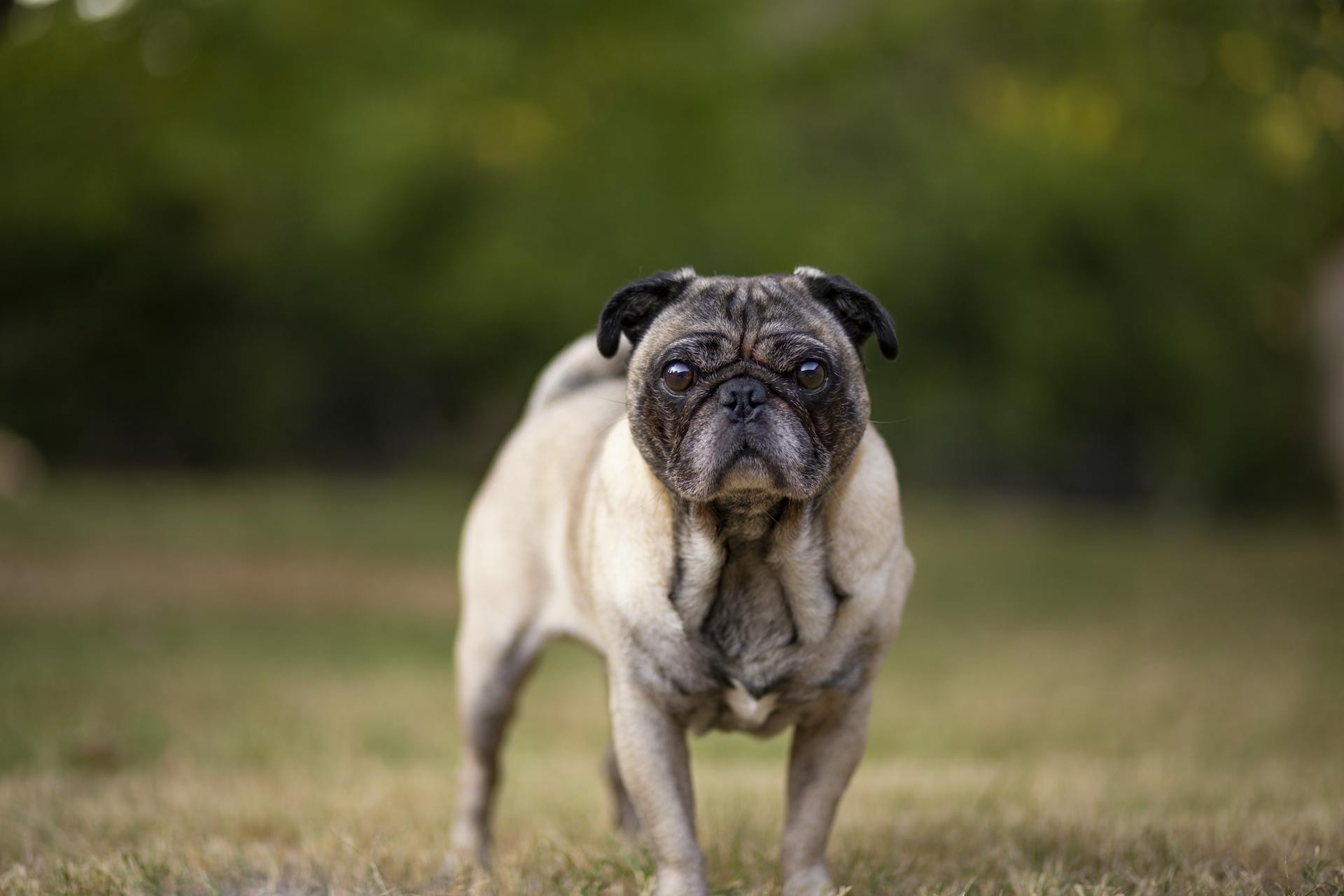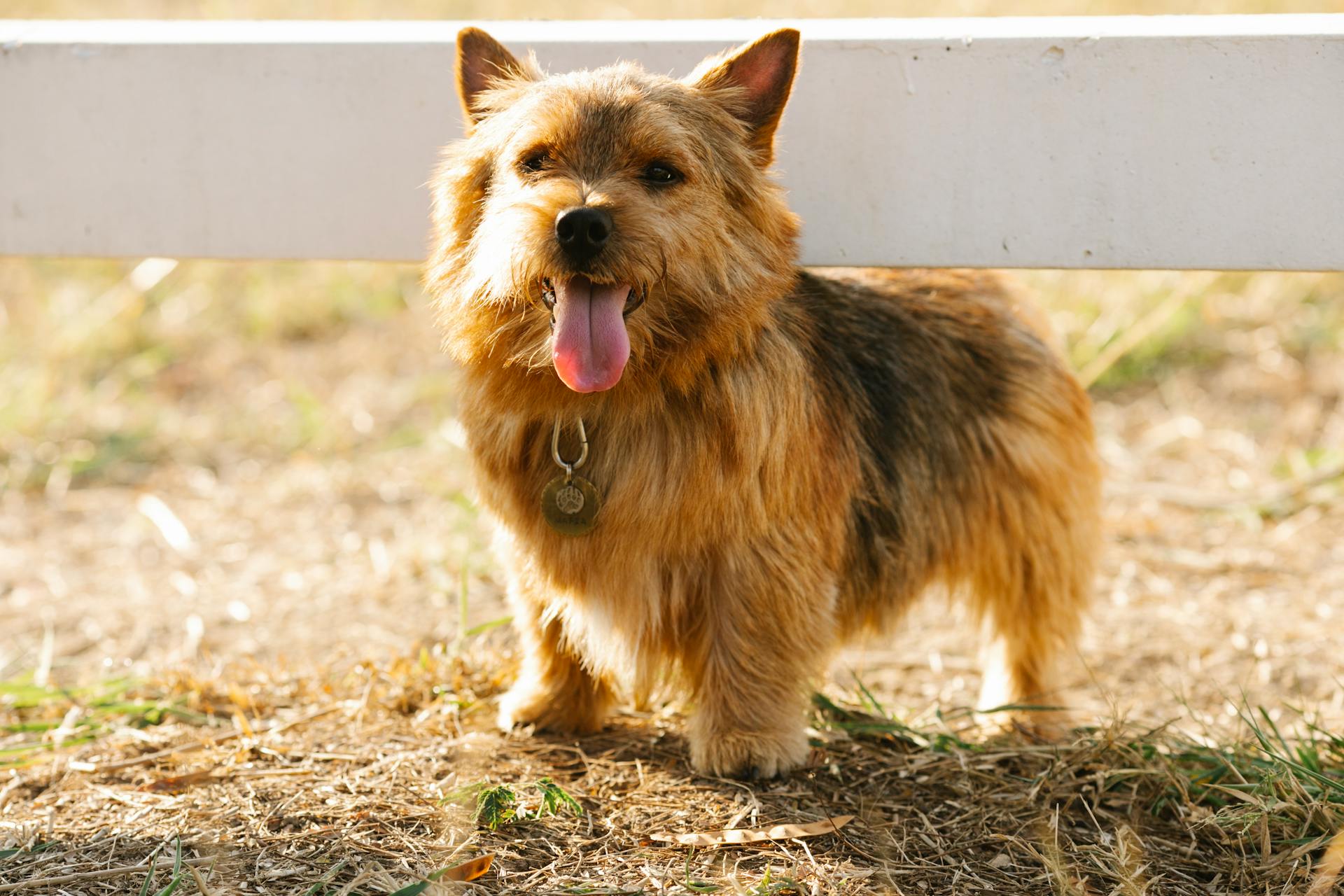
As a pug owner, you want to ensure your furry friend is at a healthy weight. According to the American Kennel Club, a pug's ideal weight range is between 10 and 17 pounds.
To determine if your pug is overweight or underweight, you can use the pug weight chart. This chart is based on the dog's height and age, with adult pugs typically weighing between 14 and 17 pounds.
Pugs that weigh less than 10 pounds may be considered underweight, while those that weigh more than 17 pounds are likely overweight. Regular weigh-ins and monitoring your pug's body condition can help you identify any weight-related issues early on.
By keeping an eye on your pug's weight and adjusting their diet and exercise accordingly, you can help them maintain a healthy weight and live a long, happy life.
Recommended read: A Guide to Managing Healthy Weight in Your Dog This Summer
Pug Puppy Growth
Pug puppies grow at a relatively fast rate, reaching their adult size by around 9 months of age. Their bone growth is established, but they may still put on muscle mass and bulk up in the following year.
Pugs typically weigh between 7 and 12 pounds at 6 months old, and will be close to their full adult height, which is around 10 to 13 inches tall. It's essential to monitor their food intake closely, as they are prone to putting on excess weight.
A Pug's growth rate can be influenced by factors such as genetics, diet, and exercise. Generally, smaller breeds tend to grow quickly and reach their adult weight by 6-8 months old, while larger breeds may not be fully grown until 12-18 months old.
Here's a rough estimate of a Pug's growth at different ages:
Keep in mind that these are just estimates, and your Pug puppy may grow at a slightly different rate. Regular veterinarian appointments will help ensure their health is being monitored and provide personalized advice on how to care for them.
Understanding Healthy Weight
Just like humans, dogs can suffer from a range of health problems when they're overweight or obese. Nearly 1 in 2 dogs seen by vets in the UK are now overweight or obese.
Knowing your dog's weight is crucial for their health, but nearly 1/3 of UK dog owners don't know their dog's current weight. It's essential to use a dog weight chart to see what your dog's body should look like at an ideal body condition and size.
Dogs that are overweight or obese are more prone to diseases such as arthritis, heart and breathing problems, diabetes, and some cancers. They also have a shorter lifespan and a reduced quality of life. Your vet can provide guidelines on how many calories to feed your dog to help them achieve a healthy weight.
Pugs, in particular, are prone to health problems due to their unique characteristics. They can stop growing by the time they're 9 months old, but may continue to put on muscle mass until they're a year old. Maintaining a healthy weight is crucial to lessening the side effects of brachycephalic syndrome, a common health problem in Pugs.
Your vet is your greatest resource in keeping your Pug happy and healthy. They can help you develop a plan to get your Pug to a healthy weight, which may involve adjusting their diet and exercise routine. With patience and the right guidance, you can see improvements in your Pug's well-being over time.
A unique perspective: Pug Dog Breathing Problems
Pug Size and Weight
A Pug's ideal weight is between 14 and 18 pounds, with a height of 10 to 13 inches.
Pugs come in a compact and solid build, rather than lean and leggy. If your Pug continues to put on weight past 18 pounds, consult with your veterinarian to ensure they are at a healthy weight.
According to the American Kennel Club Official Pug Standards, a full-grown Pug will weigh between 14 and 18 pounds and stand 10 to 13 inches tall. This is a crucial range to aim for, as canine obesity affects 25% to 30% of the general canine population.
Here's a breakdown of a Pug's growth chart:
After the 7-month marker, your Pug should maintain that range of weight. Even though you might notice them filling out, the weight should remain approximately the same.
Growth and Development
Pugs reach their adult size faster than medium to large-sized dogs, typically around nine months of age.
Their growth rate is influenced by several factors, including breed, sex, genetics, diet, and exercise.
Pugs usually reach their full adult size by the time they turn 9 months of age.
However, they may continue to put on a small amount of muscle until they are a year old.
Smaller breeds like Pugs tend to grow very quickly and reach their adult weight by the time they're 6-8 months old.
Larger breeds may not be fully grown until they are 12 to 18 months old, while extra-large breeds might not reach their adult weight until they are 24 months old.
Pugs grow at about the same rate regardless of gender, and their adult size is roughly the same for both males and females.
Here is a rough estimate of a Pug's growth rate:
Pug Feeding and Diet
A Pug's diet is crucial for their growth and overall health. A severely underfed puppy can delay growth and cause visual misses.
Take a look at this: Bernese Mountain Dog Weight Chart
It's essential to feed your Pug a correct diet, providing adequate nutrition to support their growth markers. Overfeeding can lead to significant weight gain, making your puppy off the charts for its age.
Feeding schedules for Pug puppies are specific to their age: AgeTimes Per DayDry Dog Food (cups)Wet Canned FoodHomemade or Raw (% of body weight)2–3 months4¼3 oz5–6%3–6 months31/34 oz4–5%6–12 months2¾9 oz3–4%1–8 years2½6 oz2–3%8+21/34 oz2%
Feeding your puppy an incorrect diet can deplete necessary nutrients in their body, slowing growth problems.
Readers also liked: How Much to Feed a Bernese Mountain Dog Puppy
How Much Will My Get?
Your Pug will reach its full size around nine months of age, but may continue filling out until they are a year old.
If your Pug is younger than nine months old, they are definitely still growing! Their paws should look oversized next to their legs and body, which is a classic puppy feature that indicates more growth is needed.
Reaching out to your Pug's breeder can give you a more precise estimate of their final size based on their parents and previous litters. A puppy will rarely grow to be larger than their bigger parent.
To estimate how big your puppy will get, consider factors like breed, sex, genetics, diet, and exercise.
Related reading: Xl Bully Weight Chart
Correct Diet
A well-balanced diet is crucial for your Pug's growth and overall health. If your Pug is underfed, it can delay growth and cause visual misses.
Proper nutrition is essential, and feeding your puppy an incorrect diet, like giving them adult dog food, can deplete necessary nutrients in their body, slowing growth problems.
Feeding schedules are also important, and you can refer to the following table to ensure you're on track:
Overfeeding can also cause significant weight gain, making your puppy off the charts for its age.
Measuring and Monitoring
Measuring your Pug is a crucial part of keeping track of their growth, and it's also necessary when buying a new harness or collar.
To measure your Pug effectively, you'll need a flexible measuring tape. This will allow you to get accurate calculations.
You should measure your Pug's neck, length, and chest. The neck measurement should be taken directly in the center of the ears and the base of the neck.
The length of your Pug should be measured from between the shoulder blades to the base of their tail.
The chest measurement should be taken from the back to the widest part of the chest.
Here are the areas to measure your Pug:
- Neck: Measure the circumference directly in the center of the ears and the base of the neck.
- Length: Measure between the shoulder blades to the base of your Pug’s tail.
- Chest: Measure the circumference from the back to the widest part of the chest.
Special Considerations
Pugs have a unique body shape that can affect their weight. Pugs can easily become overweight due to their compact body and short legs, making it harder for them to exercise and regulate their weight.
Their flat face also makes breathing more difficult, which can lead to obesity and related health issues. A pug's ideal weight is crucial to prevent these problems.
Pugs typically weigh between 10-17 pounds, but some can weigh up to 20 pounds. Their weight can vary depending on their height, muscle mass, and body composition.
Pugs with a higher muscle mass may weigh more, but still be within a healthy weight range. On the other hand, pugs with less muscle mass may weigh less, but still be overweight.

Pugs are prone to obesity, which can lead to serious health issues. Regular exercise and a balanced diet are essential to maintain a healthy weight and prevent obesity in pugs.
Pugs need regular check-ups with their veterinarian to monitor their weight and overall health. This is especially important for pugs, as they can easily become overweight or develop health issues if not properly cared for.
See what others are reading: Pug Dog Problems
Sources
- https://www.inchcalculator.com/puppy-weight-calculator/
- https://www.bellaandduke.com/learn/dog-health/how-much-should-my-dog-weigh/
- https://www.pawlicy.com/blog/pug-growth-and-weight/
- https://www.dailypaws.com/dogs-puppies/dog-nutrition/dog-weight-management/dog-weight-chart
- https://www.dogster.com/dog-breeds/how-big-does-a-pug-get-size-weight-growth-chart
Featured Images: pexels.com


